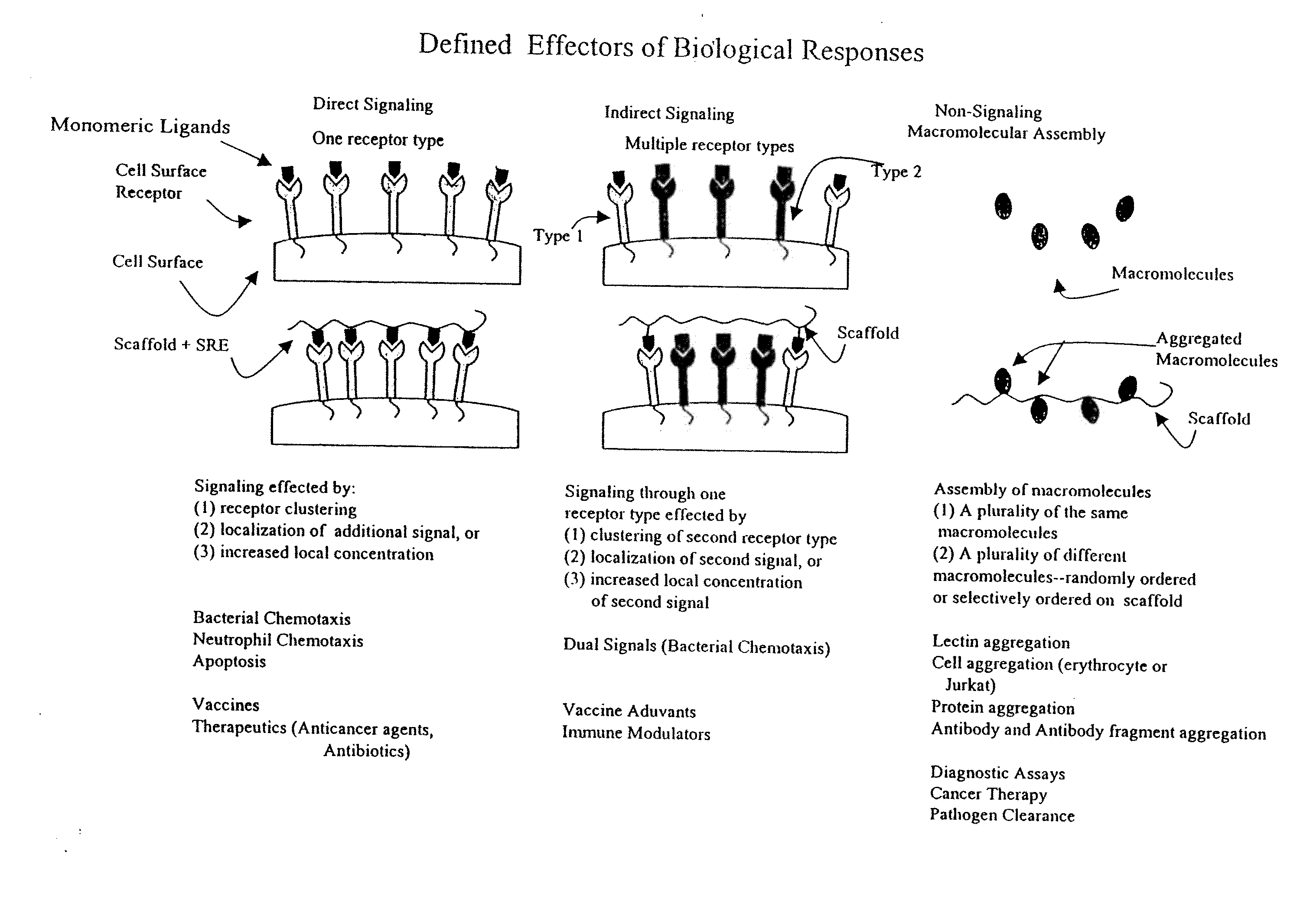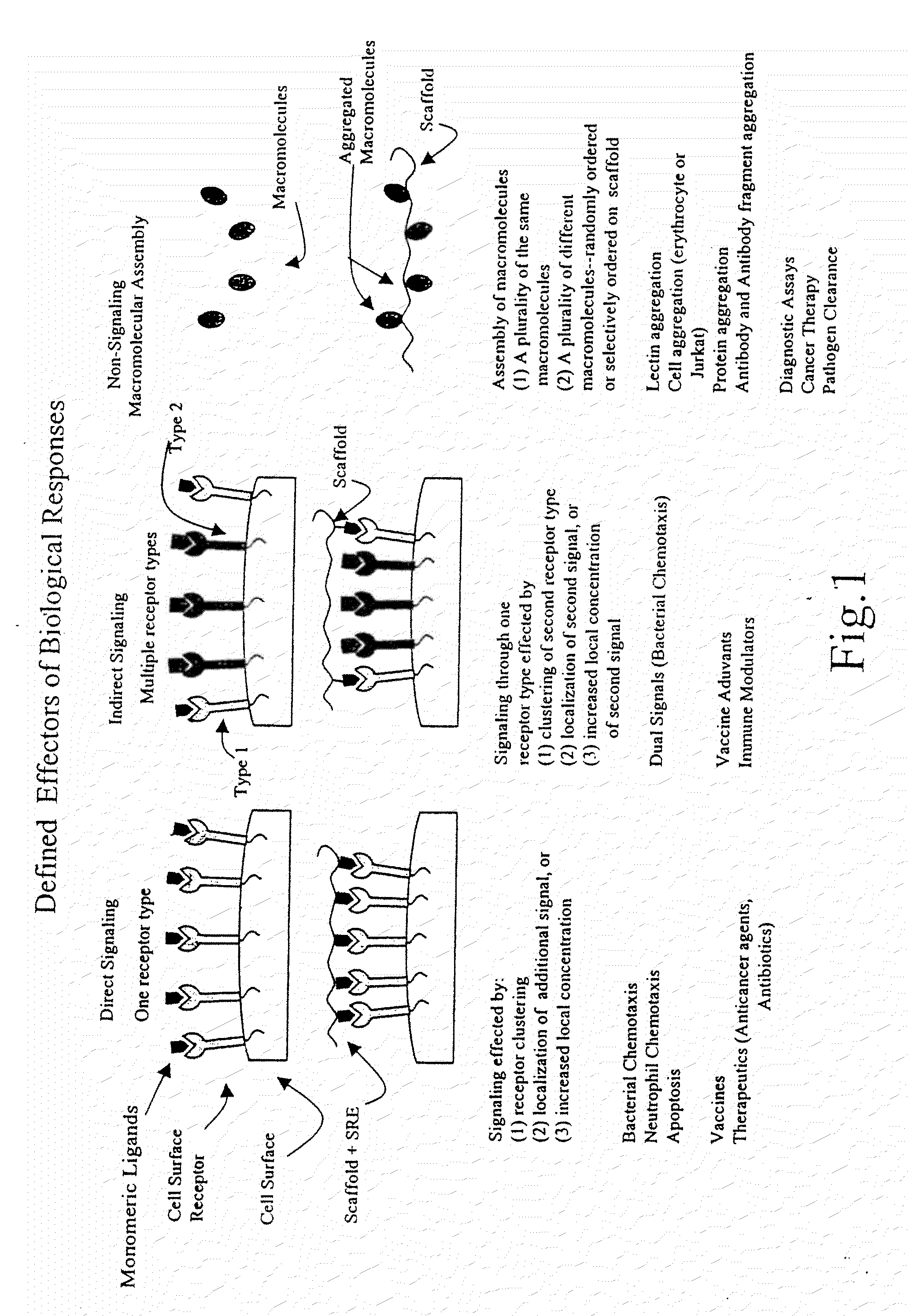Methods and Reagents for Regulation of Cellular Responses in Biological Systems
a biological system and cellular response technology, applied in the field of biological system cellular response regulation methods and reagents, can solve the problems of lack of biological activity of monovalent ligands, inability of multivalent ligands to explore this fine-tuned control in biological systems,
- Summary
- Abstract
- Description
- Claims
- Application Information
AI Technical Summary
Benefits of technology
Problems solved by technology
Method used
Image
Examples
example 1
Modulation of Bacterial Chemotaxis
[0204]The molecular events leading to bacterial chemotaxis have been well studied, and the process has served as a general model for receptor-mediated responses [Parkinson, J. S. (1993) Signal transduction schemes of bacteria, Cell, 73, 857-871; Hazelbauer, G. L., Berg, H. C., Matsumura, P. (1993) Bacterial motility and signal transduction. Cell, 73, 15-22; Alon, U., Surette, M. G., Barkai, N., Leibler, S. (1998) Robustness in bacterial chemotaxis, Nature 393, 18-19; Barkal, N., Leibler, S. (1997) Robustness in simple biochemical networks, Nature 387, 913-917]. During chemotaxis in Escherichia coli, chemoattractants, such as sugars and amino acids, and chemorepellents are recognized by specific receptors at the bacterial plasma membrane [Grebe, T. W. & Stock, J. (1998) Bacterial chemotaxis: The five sensors of a bacterium, Curr. Biol., 8, R154-R157]. For these investigations of multivalent ligand activity, galactose was selected as a model chemoattr...
example 2
Modulation of Neutrophil Chemotaxis
[0223]Neutrophil migration is an example of cell migration. Neutrophils migrate toward a number of different endogenous and exogenous substances. N-formyl peptides, bacterial protein degradation products, are one type of exogenous substance that is a chemoattractant for neutrophils [Ye, R., Boulay, F. (1997) Leukocyte Chemoattractant Receptors, Advances in Pharmacology 39:221], a bacterial transcription by product. Neutrophils have cell surface receptors which bind to the chemoattractant and can sense increasing concentration gradients of the chemoattractant. Neutrophils respond to the chemoattractant by migrating toward increased concentrations leading them to the site of infection, for example. In addition, and also in response to such chemoattractants, neutrophils release intercellular signals that affect responses in other cells, particularly other immune systems cells. Multivalent ligands of this invention can be used to enhance the response o...
example 3
Modulation of Immune Processes
[0224]The development of an immune response can be modulated via valency-dependent interactions of immune system cells with multivalent ligands of this invention. The recognition of foreign (non-self) epitopes, cells, viruses or viral particles for clearance by the immune system is due in part to cell receptors that recognize the epitopes, cells, viruses or viral particle as foreign. In order for clearance to occur, the foreign signal must be recognized and there must be a B cell or T cell response to the foreign signal. Proper immune responses require activation and subsequent deactivation of B cells and T cells. Receptor clustering on B cells and T cells has been implicated in the production of an immune response.
[0225]Multivalent ligands of this invention which have one or more BRE or SRE through which the ligand can bind to a B cell, T cell or other immune cell and which carry one or more antigens, epitopes can be employed to modulate the response o...
PUM
| Property | Measurement | Unit |
|---|---|---|
| concentration | aaaaa | aaaaa |
| pH | aaaaa | aaaaa |
| pH | aaaaa | aaaaa |
Abstract
Description
Claims
Application Information
 Login to View More
Login to View More - R&D
- Intellectual Property
- Life Sciences
- Materials
- Tech Scout
- Unparalleled Data Quality
- Higher Quality Content
- 60% Fewer Hallucinations
Browse by: Latest US Patents, China's latest patents, Technical Efficacy Thesaurus, Application Domain, Technology Topic, Popular Technical Reports.
© 2025 PatSnap. All rights reserved.Legal|Privacy policy|Modern Slavery Act Transparency Statement|Sitemap|About US| Contact US: help@patsnap.com



